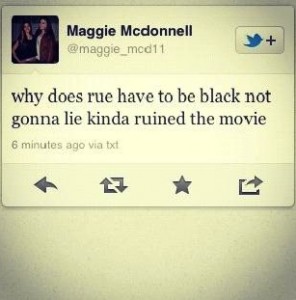Death to Lens Flares
I used to like lens flares. But after watching the 2012 remake of “Total Recall” (the boring CGI extravaganza starring some dude and Kate Whats-her-name) I just can’t stand them anymore. This movie is really shoving the OpticalFlares plugin into your face. It’s like an obnoxious mosquito in your room. STOP IT and get on with the plot already!
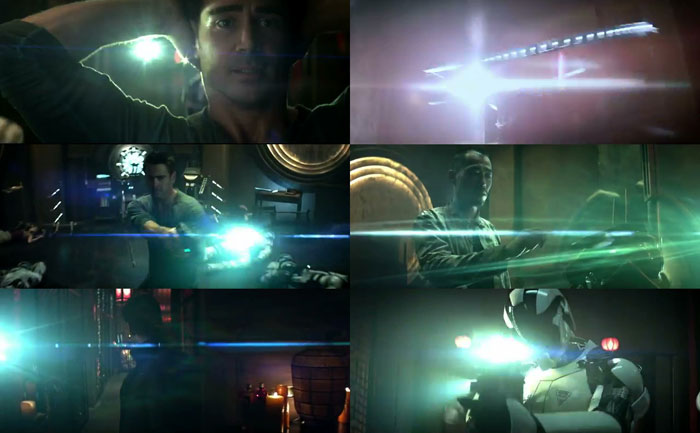
Oh. Right. Plot. That movie really has nothing else to offer but CG set extensions and optical flares.
Wait… what puts me into a position to criticize a movie that clearly has an audience? Me, who hasn’t even gone through script-writing classes? Well, as somebody who eats food I have a right to criticize a dish I didn’t like based on the fact that I’ve enjoyed a similar one in the past. I don’t have to be a cook myself 🙂 And since the internet is already full of movie criticism that nobody wants to read, I’m trying to blend some thoughts on look and VFX into my ramblings. So here we go.
If you freeze a single frame you can really see the hard work put in there by the VFX crew. I didn’t work on it but if it’s anything like the Hollywood shows I’ve worked on, it usually goes on and on like this for weeks:
Put some more sparks here, add a tiny glint over there.
Fix edge of hair on screen left.
Add more teeny-tiny holograms in the background that nobody’s gonna notice unless they print out single frames from the Blue-Ray and stare at them for a minute…
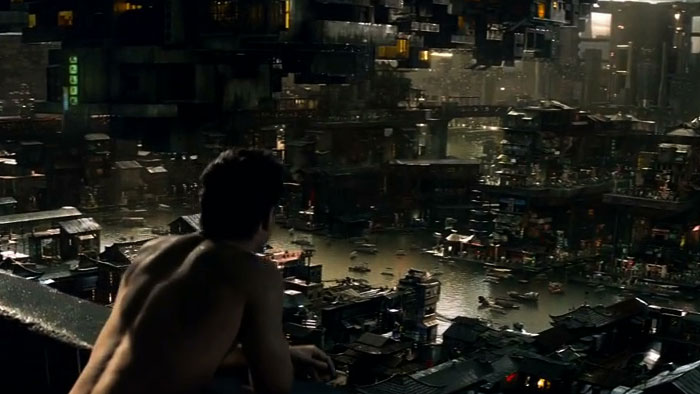
Awesome level of detail in Total Recall’s CGI set extensions (crop from HD trailer)
I can only image how many revisions the compositing artist made to the brightness of the roof to the left of Colin Farrell’s head until VFX supervisor and director were happy. 3? 5? But what good does this level of detail and photorealism do if somebody should have put more effort into script and characters instead?
I know, it’s a science-fiction movie. And the whole movie might be a dream anyways. But things like the elevator through the earth’s core or the floating buildings in the sky kept bothering me.
Questioning this kind of stuff isn’t really about questioning the thoughts that were put into a movie universe and its back story. Maybe it’s hinting at the fact that many look and set design decisions are an iterative process done in VFX postproduction (“hey, let’s put even more buildings into the background and make it look like they’re floating in the sky!”). There is one scene in Total Recall that shows how well it can work out when design decisions are rooted in the script instead: Quaid saves his life by disabling a robot soldier at lightning speed. He is able to loose two screws and rip out a circuit board in two seconds because he performed the reverse action for years while working at the robot assembly line.
But that’s not the point. Questioning sci-fi technology is more of a sign that what happens on screen just didn’t keep you engaged so your mind starts wandering. There are a lot of movie universes that I enjoy although their technology makes no sense if I start thinking about it for even a minute. The original “Total Recall” by director Paul Verhoeven is equally far out, but I can’t help but feel that Arnie’s Quaid/Hauser character was actually torn between what is true and what is just mindgames.
In 2012, Hauser/Quaid is just an underwear model being chased by a lingerie model through set pieces copied from other movies like “I, Robot” or “Minority Report”. Toned down for a PG-13 rating and the largest possible audience.
Just fire up an image search for “total recall” and compare the screenshots. Verhoeven’s version has left us with so many iconic images that still ring a bell 22 years later! Which of the top row of images will you recall in 2034?
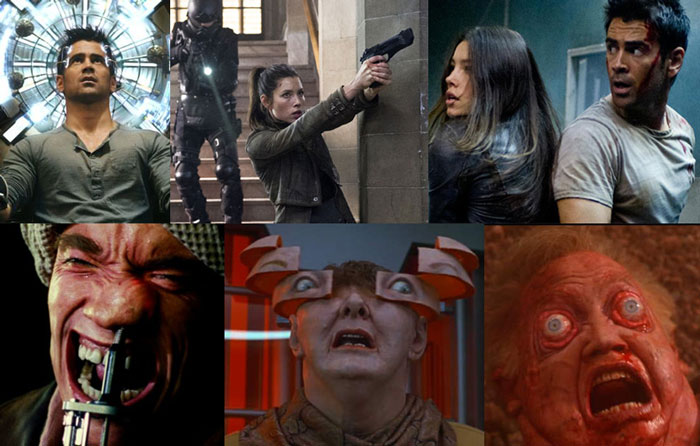
In 1990 they weren’t afraid of saturated colors yet. 2012 is – of course – orange & teal.
To sum it up, “Total Recall (2012)” is boring stuff for guys like Mr Egan from the UK who shares this nugget in an IMDB review:
PS. How can a movie not have a 10/10 when it includes a woman with not Two but THREE whole breasts?
On my scale: 5/10 (the “mediocre waste of time but not horrible” level)
Racebending
Über Film-Reviews zu “The Last Airbender” bin ich auf Racebending.com gestoßen. Die Seite betrachtet die Darstellung von ethnischen Minderheiten in Hollywoodfilmen, insbesondere die Tatsache, dass allzu oft westliche, weiße Hollywoodstars in Rollen gecastet werden, die eigentlich mit einem Asiaten besetzt werden müssten.
Ich muss zugeben, als Mitglied der “weißen männlichen Mehrheit” ist das eine Problematik, auf die ich von alleine nicht gekommen wäre. Und gleich mal vorweg: über Rassismus im Hollywoodfilm gibt’s bestimmt massenhaft Studien und Diplomarbeiten, so dass ich erst recht nicht in einem kleinen Blogeintrag ein ausgewogenes und umfassendes Urteil fällen kann… aber die ganze Racebending-Seite ist interessanter Lesestoff.
Es ist ja kein Geheimnis, dass Rassismus in Mainstream-Filmen existiert und dass das Kino die Kultur seiner Zeit widerspiegelt als auch beeinflusst. Nur dachte ich dabei bislang nur an die Bösewichte, die in den Action-Filmen der 80er halt Russen waren, und jetzt Araber. Vielleicht wäre ich noch auf die Darstellung des Japanischen Nachbarn im Klassiker “Breakfast at Tiffany’s” gekommen. Das ist so ‘offensive’ für heutige Verhältnisse, dass man sich fragt wie Amerika damals wohl tickte, wenn kurz nachdem man japanische Immigranten im 2. Weltkrieg in Internierungslager steckte in einer unverfänglichen Romanze derartige Zerrbilder dargestellt werden. Und der Nachbar wurde – das war mir bislang nicht bewusst – nichtmal von nem Asiaten gespielt! Aber das war früher. Heute ist das ja nicht mehr so, oder?
Liest man sich bei Racebending.com mehr ein, so wird deutlich wie sehr das Hollywoodkino immernoch auf weiße Hauptrollen setzt und farbige Schauspieler mit Klischee-Nebenrollen beglückt.
Verarsche zum geplanten Hollywood-Akira-Remake, das wohl mit weißen Schauspielern besetzt werden wird.
Nun mag man einwenden, dass dem halt so wäre, schließlich ist Hollywood = USA = Der Westen (TM). Aber hat das Kino (ein kommerzielles Produkt wohlgemerkt, kein sozialistisches Konstrukt) denn überhaupt den Auftrag, die Rassen gemäß ihren realen Prozentanteilen an der Bevölkerung darzustellen? Ist es nicht der Kinozuschauer, der ständig mit dem Geldbeutel wählt, und dem das anscheinend egal ist? Ist nicht der amerikanische Zuschauer die primäre Zielgruppe, und will er nicht sogar mit Vorliebe eigene weiße Stars anbeten? In Bollywoodfilmen spielen bestimmt auch Inder alle Nationalitäten.
Und man könnte sagen: Als Deutscher ist man doch auch gewohnt dass man in Filmen wahlweise als Nazi oder als Biertrinker dargestellt wird. Asiaten kriegen halt nur Rollen als Kung-Fu-Sidekick. Get over it.
Gibt es nicht wichtigere Dinge, z.B. realen Rassismus, wo tatsächlich jemand einer Bevölkerungsgruppe schaden möchte? Man denke an die “Hunger Games”-Fans, die außer sich waren, dass eine Schauspielerin schwarz war? (getreu der Romanvorlage, wohlgemerkt)
Oder nimmt man das Problem auf diese Weise zu lässig?
Schwierige Frage, wenn man eben erst auf das Thema aufmerksam wurde. Früher haben Männer sogar Frauenrollen im Theater gespielt – und die Gesellschaft fand keinen Anstoß daran. Heute wirkt das verquer. Legt Racebending.com den Finger in ein reales – wenn auch von den meisten Weißen wohl nie beachtetes – Rassismus-Problem unserer heutigen Gesellschaft, das zu beheben genauso wichtig ist wie es mal war, das Frauenwahlrecht einzuführen?
Auf jeden Fall würde ich den Leuten hinter Racebending.com nicht sagen, sie sollen mal nicht so empfindlich sein. Ich finde, die Vorwürfe haben durchaus Hand und Fuß.
Den Machern von Racebending.com geht’s ja bestimmt nicht darum, dass es schlimm sei, wenn es Hollywood-Remakes von asiatischen Filmen gibt, in denen nur Weiße mitspielen. Solange die Story halt ebenso komplett in den Westen transferiert wird (siehe “The Departed“).
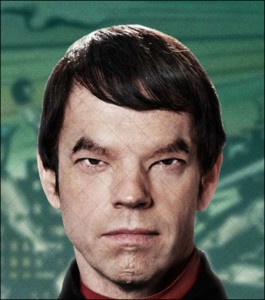 Ihnen liegt vermutlich eher am Herzen, dass man über die Vorurteile nachdenkt, die Hollywood im Jahre 2012 perpetuiert und den Aufwand, den man betreibt, um selbst asiatische Hauptrollen mit Weißen zu besetzen. Ich meine, für “Cloud Atlas” hat sich Hugo Weaving Schlitzaugen machen lassen. Das ist eigentlich schon ‘ne derbe Nummer. Wenn er sich schwarz schminken würde, um statt Forest Whitaker in “Last King of Scotland” zu spielen? Undenkbar, oder?
Ihnen liegt vermutlich eher am Herzen, dass man über die Vorurteile nachdenkt, die Hollywood im Jahre 2012 perpetuiert und den Aufwand, den man betreibt, um selbst asiatische Hauptrollen mit Weißen zu besetzen. Ich meine, für “Cloud Atlas” hat sich Hugo Weaving Schlitzaugen machen lassen. Das ist eigentlich schon ‘ne derbe Nummer. Wenn er sich schwarz schminken würde, um statt Forest Whitaker in “Last King of Scotland” zu spielen? Undenkbar, oder?
Anmerkung, nachdem ich Cloud Atlas gesehen habe: Der Film ist fantastisch, und es hat einen guten Grund, dass Weaving einen Asiaten spielt, genauso wie alle anderen Schauspieler multiple Rollen mit unterschiedlichen Rassen und Geschlechtern spielen. Dem Film Rassismus vorzuwerfen ist sowas von blödsinnig, dass man sich an den Kopf fassen muss.
Und wie ist das ganze in Deutschland? Werden hier nicht auch Türken im Kino und TV unterrepräsentiert und dürfen nur Gemüseläden besitzen während Russen im Tatort immer Zuhälter sind?
Food for thought.
PS: Hier ein Artikel, der sich über “whitewashing” von Filmrollen mokiert.
Looper: Closing a year of over-hyped sci-fi flicks.
Ok. Time-travel movies are impossible to get right. But come on… people have tried harder in the past.
Looper – the “next Matrix” or whatever it gets called in the hype machine that is cinema in 2012 – starts witty and fast, but its initial idea gets tangled up by time paradoxes and it gets slower and slower. The production design is nice, but the random outbursts of sadistic violence sickened me. Yes, Bruce Willis is bad-ass as always. But it feels like he was cast simply because Looper feels like a bad adaptation of Twelve Monkeys.
Instead of trying to evade time paradoxes, Looper’s script writers even go over the top in that they are introducing us to people with telekinetic abilities early on in the film. Then they completely forget about them and their implications on society for the rest of the movie (and about 30 years into the future).
Why not introduce fire-breathing dragons as well? If you can just get rid of time paradoxes at will and you already have X-Men in the movie… why not go ALL the way?
Still… 7 out of 10 for stylistically fusing the 1950s and 2040’s 🙂
Go See Cabin In The Woods
I think “Movie Bob” called it the best thing you’re gonna see this summer, and I think he was right. After having watched hyped blockbusters like Batman and Prometheus with a bitter taste in my mouth I was delighted to actually enjoy a movie all the way.
“Cabin in the Woods” is kinda hard to describe without spoiling anything. So I won’t. From the very first scene it’s clear that the movie is a mix of genres. Never since “Scream” have I seen a horror movie that takes such a fresh and hilarious take on the familiar “a group of attractive students gets killed in the woods” story. I enjoyed the fact that most of the time the movie looked like a good old 80’s flick with makeup effects instead of CGI.
Here’s the trailer (can’t be embedded, sorry)
9/10 (the “must-see” level)
Jeder ist ein Kritiker
…aber nicht unbedingt ein guter 🙂 Hier sind ein paar englische Film-Blogs, deren Stil ich sehr mag:
Film Critic Hulk Smash: Hier schreibt der Incredible Hulk persönlich über Filmemacherei und Kinofilme. Der Stil – durchgehend in Großbuchstaben und mit Höhlenmensch-Gramatik – macht das Lesen nicht leicht, doch es lohnt sich. Hulk’s Filmrezensionen sind ellenlang, sehr emotional und philosophisch. Auch wenn man beim Lesen einfach nicht die Intonation vom echten Hulk aus dem Kopf kriegt.
Sam Strange Remembers: Im selben Magazin (Badass Digest) wie Hulk schreibt auch “Sam Strange”, dessen Ansatz nicht weniger cool ist. Der Autor verreißt Filme, indem er tut als würde der jeweilige Produzent die Geschichte nacherzählen (also Achtung, das Ende wird verraten). Sein Alter Ego ist quasi Hollywood’s zynischster Produzent, der für alle Filme verantwortlich ist und genüsslich erzählt, wie er sie absichtlich schlampig produziert, um den Zuschauer zu verarschen. Großartig!
In die gleiche Kerbe schlagen die “Kurzdrehbücher” von The Editing Room. Auch hier geht es darum, die Film durch den Kakao zu ziehen und dabei Filmfehler und Schlampereien hervorzuheben.
Und zu guter Letzt noch ein Filmblog, in dem sich der Autor ernsthafter mit den Streifen auseinandersetzt: Movie Bob (bereits in einem früheren Blogeintrag besprochen).
Prometheus
I enjoyed that movie. Even though it had a bunch of silly moments they didn’t ruin the movie for me as they did in “The Dark Knight Rises“.
The movie’s genre is less science fiction (since everything in the plot that has a “science” label on it is so stupid it hurts) and more a stock splatter/horror movie where people get killed off one by one because of their obviously stupid and careless actions. The plot is advanced by stupidity only, to be honest. If anybody would act like scientists instead of school children on a field trip to the zoo, there would be no plot.
But again, that didn’t keep me from enjoying Prometheus. It was adequately scary and gross and there was a lot of eye-candy. I don’t care if it doesn’t answer some things or whether it is a seamless prequel to Alien. So yes, I liked it for its looks, not for its personality.
What made me scratch my head though was Roger Ebert’s raving four-star review of Prometheus. Magnificent – intriguing – spellbinding! Seriously? It was high production value popcorn cinema. But it certainly doesn’t deserve adjectives that Ebert usually uses on obscure art-house dramas.
The 3D trailer for Resident Evil, on the other hand, was the worst thing I ever had to endure behind stereo glasses.
Link: The Editing Room’s abridged script for Prometheus touches on all the plot holes.
7/10 (the “better than average” level)
The Dark Knight Thumbs Down
Christopher Nolan’s supposed masterpiece finale is a dud. A movie so stupid it’s insulting.
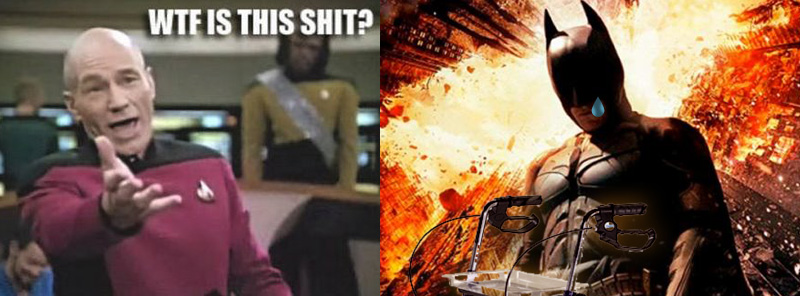
I used to scoff at those guys who seemed to remember every plot hole in movies they’ve watched. Reading their reviews or the fake scripts at the-editing-room.com is funny but I think “wow, that never struck me during the movie, the mood was right and the action covered it up, these guys really have no life”.
Not with The Dark Knight Rises. It’s just full of god-awful plot holes and one deus ex machina after another. It just ruined the movie for me.
Bruce Wayne goes from geriatric to Ninja using a handy knee gadget he had lying around in his lab. Then he gets almost beaten to death but then gets his spine fixed by a slap on the back from a cave doctor somewhere in a generic Arabian country and – boom – after some bench pressing he can jump again like a world class athlete.
All of Gotham City’s 3000 cops are trapped in the sewers for three months. After they finally get out, they are clean-shaven and are wearing untarnished uniforms.
The film’s big surprise plot twist at the end is surprising only because it’s the most random thing the scriptwriters could think of. And thinking they didn’t do much. Every girl in the film (that’s 2) gets to be a love interest. To make up for the lack of estrogen, there’s the most amount of man-tears a mainstream action movie has had so far. Bruce Wayne, his butler, even the bad guy… they all get to bawl when they are confronted with their childhood memories.
Seriously, how can that movie get an IMDB score of 9.0? Don’t tell me that action movies have always had these plot holes. What else does that film have left? Fist fights? The most non-aerodynamic flying machine ever seen on screen since the Jetsons? A nuclear mushroom cloud that looks comped in like from an AfterEffects tutorial?
Meh.
